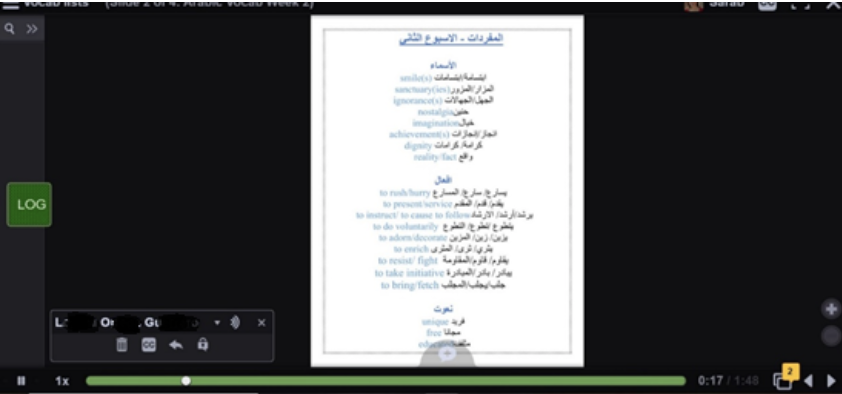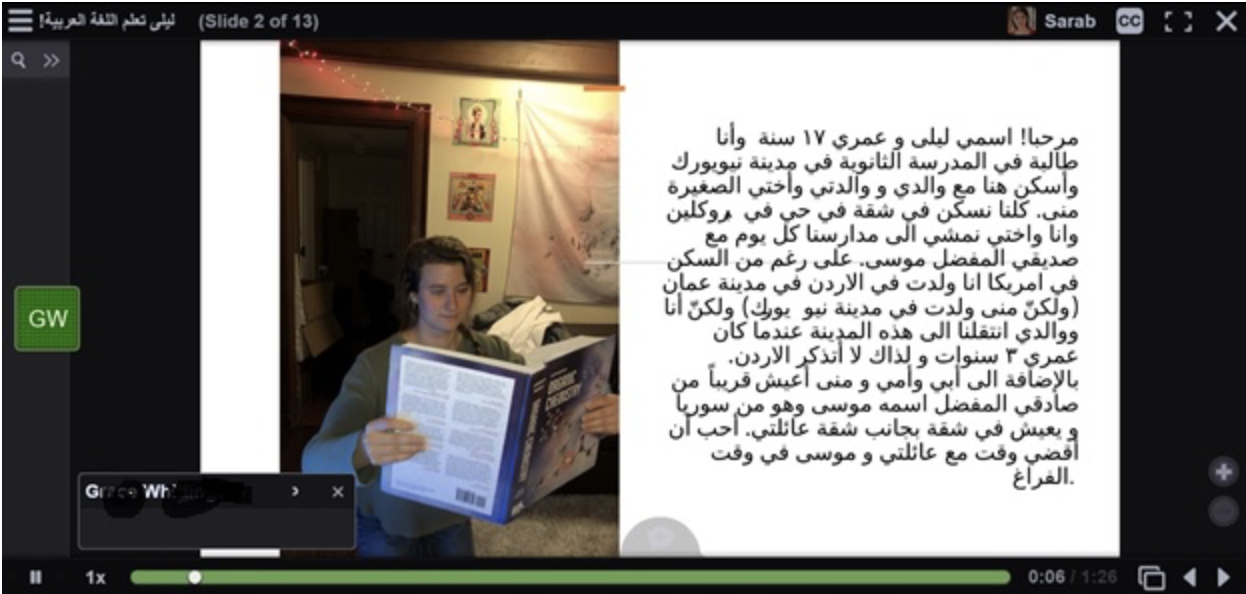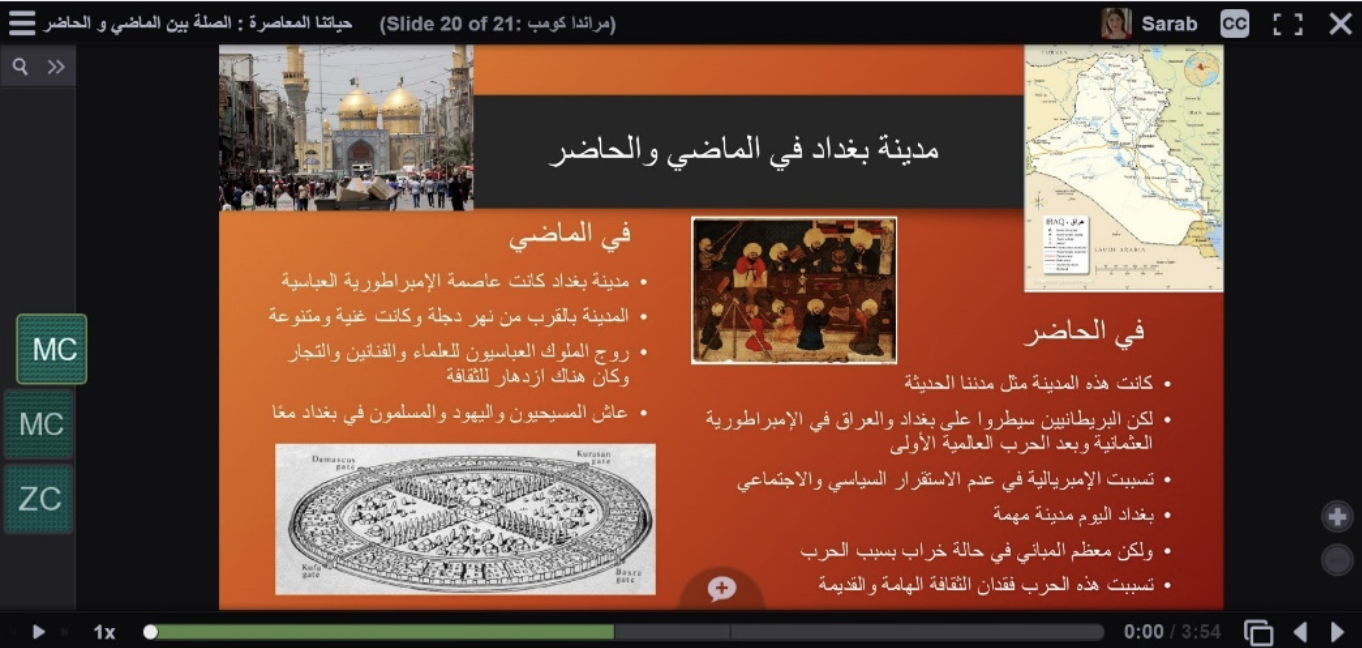Three VoiceThread Designs that are Based on Research Findings
Research tells us that combining orthographic and phonological forms of language has many benefits for language learning. Nakashima, Stephens and Kamata (2018) found that reading-while-listening increases comprehension. Mestres, Baro and Garriaga (2019) found that combining text with audio helps children (10 to11 years of age) obtain higher vocabulary when learning a second language. Valentini, Ricketts and Pye (2018) had similar findings with children between 8 and 9 years of age when reading short stories. The results were not much different when the learners were adults or when the tasks were longer. Milliner (2019) tells us that university students learned more vocabulary overtime when they when their instructors combined orthographic and phonological forms of the texts. The study that Feng and Webb completed (2019) has similar findings for university students especially when image (s) was added.
The five studies mentioned above are only a few of the recent ones that have investigate this technique. There are many more that investigate the same technique with different subjects and in different combinations. The majority of these studies indicate gains in terms of language learning. But what does that mean for us language educators? How do we make use of these research findings while working according to the standards of the American Council on The Teaching of Foreign Languages (ACTFL)? Where is technology in all of this?
Combining text with audio may have been challenging on the technical and practical level decades ago. But now with advent of technology and technological tools it is no longer such a challenge. And with VoiceThread specifically, creating this combination takes literally few pushes on the same button (go to tutorial here) . Moreover, with VoiceThread, language educators are not the only ones who can create this combination. Language learners can create it too with the same level of ease and possibly more benefits.
So, let us go through several combinations that I myself have used and am using, in which text, audio, and image are be combined effectively for the purpose of language teaching and learning all of which created by the student rather than the instructor.
- Students created vocab list.
Students centered learning and student collaboration are major pedagogical practices that language educators adopt in their teaching as they try to implement the 21st Century Skills Map.
I designed the VoiceThread-based activity below in a way that follows these tow practices, where students in Advanced Arabic II take turns each week to create the vocab list for that week.
And to get the benefits of combining text with audio, the student whose turn it is must upload the written list and a recording of the same list. Other students use this vocab list to help them as they prepare for the week’s reading.

Picture 1 Students on Advanced Arabic II create their own vocab list with text and audio
2. Students final project; a short story.
As students in Intermediate High-Level work to produce language in the paragraph level rather than the sentence (or sting of sentences) level, it becomes important for the language educator to design activities that target this type of production. This is one such task. Without going into the full details, my students of Intermediate Arabic I, must write a short story as one part of their final project. They must select a theme that is culturally appropriate, work on their draft with me, their TA, and/or their language partner to finalize it. Once they are done, they then create a VoiceThread in which they must add the text along with appropriate pictures and audio recording (create an e-book, plus audio). During the last few of days in the semester, students read and listen to the stories their colleagues created and give each other feedback.

Picture 2 Students of Intermediate Arabic I create their own short story with image, text and audio
3. Students share findings.
When defining Connections as one of the 21st century skills, ACTFL says: “Students are able to access knowledge in other disciplines through the target language and to reinforce concepts already learned in these disciplines in the language classroom” (ACTFL 21st Century Skills Map, p.3, 2011). To develop this skill, my students of Advanced Arabic I must, on biweekly basis, search the internet (using the target language) to find similar topics that were dealt with in class and under the same theme but in an Arab country other than the one that was discussed in class. They must show their findings in the form on an info-graph. After having completed the info-graph, they need to add a slide to a VoiceThread that I already created and that is designated for that theme. One the same slide they must also record their findings which can be identical to what they have written in the info-graph (reading it out loud) but it does not have to be (they can free-talk if they like). Students listen to their peers’ recordings and read their info-graphs. After having done so, they need to add an audio comment with a specific piece of information that might be similar, different, at odds with …etc. in comparison to what they found when they conducted their search.

Picture 3 Student of Advanced Arabic I share their findings in a VoiceThread slide
Technology and technological education tools are not a magic solution to teaching or learning. Using research findings to guide the design learning activities is one way to ensure their effectiveness. Updating, differentiating and personalizing these tasks are other techniques to keep them effective. And always use recent, relevant and related research findings to guide the way in which to use technology.
About the Author Sarab Al Ani is a senior lector in Arabic at Yale where she’s been teaching for ten years. Her research interests focus on using technology for language teaching, teaching Arabic in the U.S., improving second language skills with minimum of difficulty, and optimum testing methods. She also offers online courses on Second Language Teaching and Learning with ViaX. She is one of the leadership members of the New York Arabic Language Teachers Council where she offers teacher training workshops and presentations. A writer and a blogger, she wrote two Arabic Language teaching books, blog posts for the Center for Language Study at Yale, the American Association of Teachers of Arabic blog, as well as New Education Blog. Sarab is an active certified tester and rater with the American Council on the Teaching of Foreign Languages for both the Oral Proficiency Interview as well as the ACTFL Assessment of Performance Towards Proficiency in Languages test. https://campuspress.yale.edu/sarabalani/
Resources:
ACTFL. (2011). 21st century skills map.
Feng, Y., & Webb, S. (2019). LEARNING VOCABULARY THROUGH READING, LISTENING, AND VIEWING: WHICH MODE OF INPUT IS MOST EFFECTIVE?. Studies in Second Language Acquisition, 1-25.
Mestres, E. T., Baró, À. L., & Garriga, À. P. (2019). Linguistic and non-linguistic outcomes of a reading-while-listening program for young learners of English. Reading and Writing, 32(3), 819-838.
Milliner, B. (2019). Comparing Extensive Reading to Extensive Reading-While-Listening on Smartphones: Impacts on Listening and Reading Performance for Beginning Students. The Reading Matrix: An International Online Journal, 19(1).
Nakashima, K., Stephens, M., & Kamata, S. (2018). The Interplay of Silent Reading, Reading-while-listening and Listening-only. The Reading Matrix: An International Online Journal, 18(1), 104-123.
Valentini, A., Ricketts, J., Pye, R. E., & Houston-Price, C. (2018). Listening while reading promotes word learning from stories. Journal of experimental child psychology, 167, 10-31.
